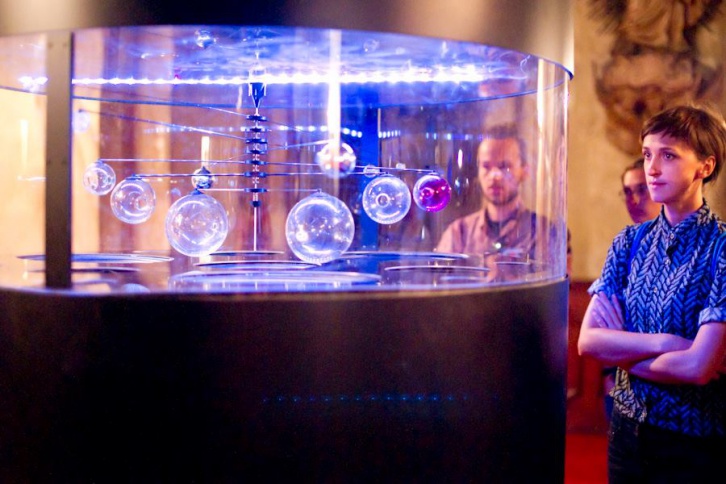Nataša Muševič – Dot: Intervals
August 23rd - September 5th 2013, @Križevniška cerkev, Trg Francoske revolucije, Ljubljana
Exhibition opening: Friday, August 23rd, 7pm, with music support by Some1Else and Bartillier
Exhibition guided tour: Monday, August 26th, 7pm
Opening hours: every day from 4pm till 10pm, Saturdays and Sundays from 12pm till 9pm
In 2014: From May 30th till June 25th 2014, @Dimenzija napredka gallery, Solkan, Nova Gorica, Slovenia
The particle and wave duality of nature exists on any scale in any dimension. If we considered objects in nature around us just as bodies with mass and discard their wave function, this perception would lead to pure ignorance.
The steps of the chaotic system around us, the basic intervals that combine into infinite possibilities that form our world, our universe, and especially their fractal nature allow us a visualization of a basic stable system of natural flow, an illustration of phase systems of many body problem / multiple wave function. By shifting them into the human scale, the project depicts the texture of the universe in the form of a harmony made of intervals extrapolated from the data on the basic frequencies on both quantum and (inter-)planetary scale.
But at the end it is up to the observer to decide whether the observed objects are just a group of circulating bodies or merely waves trapped in a form.
Concept
Sound installation Intervals is a first solo art piece by intermedia artist and musician Nataša Muševič – Dot, striving to research the existence of naturally present intervals in our universe. The installation consist of numerous spherical objects circulating around the installation’s central axis, being driven by sound i.e. by their own resonance.
The installation itself is an audial and physical illustration of sequences of intervals, the proportions of which are derived from empirical research data and scientific measurements. In search of perfect harmony, the author compared frequencies of natural intervals present in electrons rotation with the relations of the frequencies of the planets in our Solar system. These proportions were then transformed into sound, but they still preserve their mutual correlations and are thus presented in a harmonical form.
The idea of Intervals originates in wave–particle duality theory, which explains the frequency properties of matter at the atomic scale and adapts it to the viewer’s visual scale. Thus the author poses the question of boundary between matter and waves and offers the viewer to rethink the question: is the circulating sphere truly substantive or is it just a sound frequency? Is the world around us really physically perceptible or are we merely surrounded by different forms of waves?

There has been numerous attempts by the world musical theorists and nations to find the ultimate harmony in which to write music. Harmony, as we know it culturally, is like language, it depends on its cultural origin and is passed on by the members of society. Diverse range of known musical harmonies include the standard major and minor harmonic progressions known in the west, but also diverse harmonies of India where intervals follow one another at ¼ tone, rather than ½ known in the West. From pentatonic Scale to Middle Eastern harmonies, we clearly observe musical harmony to be a part of a culture.
But where do the natural emotions expressed through melodies in a certain harmony come from? Are there any natural ways to explain intervals used in a harmony and where do musicians instincts of intervals come from?
The project Intervals aims to find a relativistic sort of a harmony that is derived from empirically/scientifically measured steps/values from which the nature around us is build. There are many constants known to humankind, which themselves alone point to the periodical repetition of some values throughout observed systems. Some constants are compound/bound to the forces and physical theories explaining their origins (G=gravity constant) and therefore are nor scalable across all physical phenomena (example quantum world). But there are also constants, on the other hand, that are free from being bound to certain physical scale or theory and are therefore mainly mathematical in origin (Pi). While physics always aims to be subjective (even Einstein’s relativity theory only solves any given problem at once for merely one point of view), mathematics seems to approach more distant/objective description of nature around us.
The project therefore tries to gather data empirically tested and measured by means of physical experimentation and translate them into the world of mathematics. This transformation is at the same time one of the core concepts of Intervals, because the root of subjective harmony which Western world has culturally accepted as normal (major and minor) is equally problematic to creation of objective harmony-music composition, as physics is to objective physical theories.
As a musician Nataša tends to have the professional deformation of striving to find a ‘perfect harmony’, the problem which has been troubling many people around the world for many centuries. And while each new harmonic theory enables us to express certain view of the world, Nataša’s is yet another try.
This text is an extract from the author’s extensive study about the project. It is fully accessible here.
About the author
Nataša Muševič aka Dot is a music producer, singer, song writer, record label manager and a multimedia artist. She moved to London at the age of 19 to study sound engineering and later finished her honours degree in Recording Arts at London's SAE Institute. During her years in London Nataša managed Immigrant Recordings with Subeena which was the first dubstep record label managed by female producers, and later on funded her own record label Read Write Music. Natasha's work in intermedia art extends to collaborative projects such as Magnetic Matrix (with Marko Batista), Sonične Skulpture (with Boštjan Čadež, Marko Batista and Satja Lumbar) and Sonosthesia (with Jernej Marušič a.k.a. Octex). Her interest in multimedia art aims to include continuous research of sonic frequencies which have always been the main focus of Nataša's creations and also part of her first solo intermedia project Intervals.
Acknowledgements
Maja and Igor Muševič, Igor Križanovskij, Jaša Bizjak, Marko Batista, Darko Brlek, Alenka Banovec, Željko Pelicon, Marko Peljhan, Pajo, Adam Muzafirovič, Dominik Mahnič, Brane Filipič, Maja Kocjan, Gašper Premože, Andraž Tarman, Boris Petovar, Primož Žagar, Peter Kolobarič, Slavko Glamočanin,Tjaša Flis, Blaž Remškar, Srđan Prodanovič, Aleksandar Pejić, Žiga Kranjec, Boris Šaletič, Matija Praznik, Jernej Černologar and to all, who believed it’s possible.
Production
Project was developed as a co-production between Zavod Projekt Atol and Ljudmila, with the support of Festival Ljubljana.
Production of the project was supported by Ministry of Culture.
